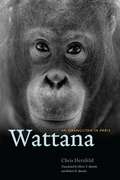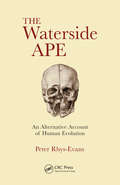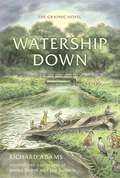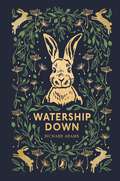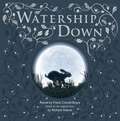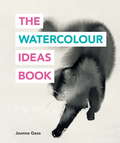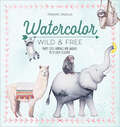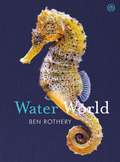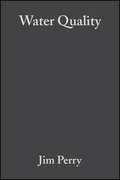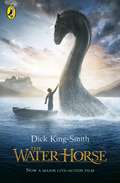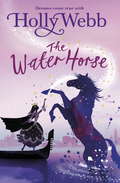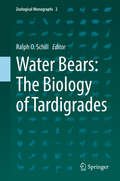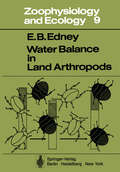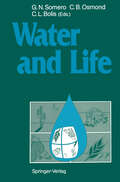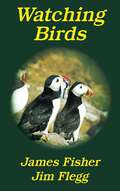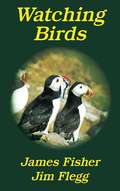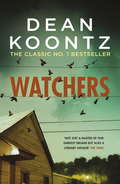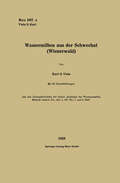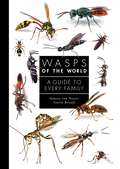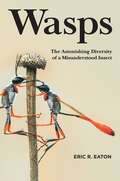- Table View
- List View
Wattana: An Orangutan in Paris
by Chris HerzfeldShe likes tea, sews, draws on papers and is a self-taught master of tying and untying knots. But she is not a crafty woman of the DIY set: she is Wattana, an orangutan who lives in the Jardin des Plantes Zoo in Paris. And it is in Paris where Chris Herzfeld first encounters and becomes impressed by Wattana and her exceptional abilities with knots. In Wattana: An Orangutan in Paris Herzfeld tells not only Wattana’s fascinating story, but also the story of orangutans and other primates—including bonobos, chimpanzees, and gorillas—in captivity. Offering a uniquely intimate look at the daily lives of captive great apes, Herzfeld uses Wattana’s life to trace the history of orangutans from their first arrival in Europe in 1776 to the inhabitants of the Zoo of Paris and other zoos today. She provides a close look at the habits, technical know-how, and skills of Wattana, who, remarkably, uses strings, paper rolls, rope, and even pieces of wood to make things. And she thoughtfully explores how apes individually—and often with ingenuity—come to terms with and adapt to their captive environments and caretakers. Through these stories, Wattana sympathetically reveals the extraordinary psychology and distinctive personalities of great apes as well as the interconnections between animal and human lives, especially in zoos. Scientists predict that orangutans will disappear from the wild by 2030, and captive animals like Wattana may, as a result, provide our best chance to understand and appreciate their astonishing intelligence and abilities. Wattana, the accomplished maker of knots, is the hero of this poignant book, which will enthrall anyone curious about the lives of our primate cousins.
Wattana: An Orangutan in Paris
by Chris HerzfeldShe likes tea, sews, draws on papers and is a self-taught master of tying and untying knots. But she is not a crafty woman of the DIY set: she is Wattana, an orangutan who lives in the Jardin des Plantes Zoo in Paris. And it is in Paris where Chris Herzfeld first encounters and becomes impressed by Wattana and her exceptional abilities with knots. In Wattana: An Orangutan in Paris Herzfeld tells not only Wattana’s fascinating story, but also the story of orangutans and other primates—including bonobos, chimpanzees, and gorillas—in captivity. Offering a uniquely intimate look at the daily lives of captive great apes, Herzfeld uses Wattana’s life to trace the history of orangutans from their first arrival in Europe in 1776 to the inhabitants of the Zoo of Paris and other zoos today. She provides a close look at the habits, technical know-how, and skills of Wattana, who, remarkably, uses strings, paper rolls, rope, and even pieces of wood to make things. And she thoughtfully explores how apes individually—and often with ingenuity—come to terms with and adapt to their captive environments and caretakers. Through these stories, Wattana sympathetically reveals the extraordinary psychology and distinctive personalities of great apes as well as the interconnections between animal and human lives, especially in zoos. Scientists predict that orangutans will disappear from the wild by 2030, and captive animals like Wattana may, as a result, provide our best chance to understand and appreciate their astonishing intelligence and abilities. Wattana, the accomplished maker of knots, is the hero of this poignant book, which will enthrall anyone curious about the lives of our primate cousins.
Wattana: An Orangutan in Paris
by Chris HerzfeldShe likes tea, sews, draws on papers and is a self-taught master of tying and untying knots. But she is not a crafty woman of the DIY set: she is Wattana, an orangutan who lives in the Jardin des Plantes Zoo in Paris. And it is in Paris where Chris Herzfeld first encounters and becomes impressed by Wattana and her exceptional abilities with knots. In Wattana: An Orangutan in Paris Herzfeld tells not only Wattana’s fascinating story, but also the story of orangutans and other primates—including bonobos, chimpanzees, and gorillas—in captivity. Offering a uniquely intimate look at the daily lives of captive great apes, Herzfeld uses Wattana’s life to trace the history of orangutans from their first arrival in Europe in 1776 to the inhabitants of the Zoo of Paris and other zoos today. She provides a close look at the habits, technical know-how, and skills of Wattana, who, remarkably, uses strings, paper rolls, rope, and even pieces of wood to make things. And she thoughtfully explores how apes individually—and often with ingenuity—come to terms with and adapt to their captive environments and caretakers. Through these stories, Wattana sympathetically reveals the extraordinary psychology and distinctive personalities of great apes as well as the interconnections between animal and human lives, especially in zoos. Scientists predict that orangutans will disappear from the wild by 2030, and captive animals like Wattana may, as a result, provide our best chance to understand and appreciate their astonishing intelligence and abilities. Wattana, the accomplished maker of knots, is the hero of this poignant book, which will enthrall anyone curious about the lives of our primate cousins.
Wattana: An Orangutan in Paris
by Chris HerzfeldShe likes tea, sews, draws on papers and is a self-taught master of tying and untying knots. But she is not a crafty woman of the DIY set: she is Wattana, an orangutan who lives in the Jardin des Plantes Zoo in Paris. And it is in Paris where Chris Herzfeld first encounters and becomes impressed by Wattana and her exceptional abilities with knots. In Wattana: An Orangutan in Paris Herzfeld tells not only Wattana’s fascinating story, but also the story of orangutans and other primates—including bonobos, chimpanzees, and gorillas—in captivity. Offering a uniquely intimate look at the daily lives of captive great apes, Herzfeld uses Wattana’s life to trace the history of orangutans from their first arrival in Europe in 1776 to the inhabitants of the Zoo of Paris and other zoos today. She provides a close look at the habits, technical know-how, and skills of Wattana, who, remarkably, uses strings, paper rolls, rope, and even pieces of wood to make things. And she thoughtfully explores how apes individually—and often with ingenuity—come to terms with and adapt to their captive environments and caretakers. Through these stories, Wattana sympathetically reveals the extraordinary psychology and distinctive personalities of great apes as well as the interconnections between animal and human lives, especially in zoos. Scientists predict that orangutans will disappear from the wild by 2030, and captive animals like Wattana may, as a result, provide our best chance to understand and appreciate their astonishing intelligence and abilities. Wattana, the accomplished maker of knots, is the hero of this poignant book, which will enthrall anyone curious about the lives of our primate cousins.
The Waterside Ape: An Alternative Account of Human Evolution
by Peter H. Rhys EvansWhy are humans so fond of water? Why is our skin colour so variable? Why aren’t we hairy like our close ape relatives? A savannah scenario of human evolution has been widely accepted primarily due to fossil evidence; and fossils do not offer insight into these questions. Other alternative evolutionary scenarios might, but these models have been rejected. This book explores a controversial idea – that human evolution was intimately associated with watery habitats as much or more than typical savannahs. Written from a medical point of view, the author presents evidence supporting a credible alternative explanation for how humans diverged from our primate ancestors. Anatomical and physiological evidence offer insight into hairlessness, different coloured skin, subcutaneous fat, large brains, a marine-type kidney, a unique heat regulation system and speech. This evidence suggests that humans may well have evolved, not just as savannah mammals, as is generally believed, but with more affinity for aquatic habitats – rivers, streams, lakes and coasts. Key Features: Presents the evidence for a close association between riparian habitats and the origin of humans Reviews the "savannah ape" hypothesis for human origins Describes various anatomical adaptations that are associated with hypotheses of human evolution Explores characteristics from the head and neck such as skull and sinus structures, the larynx and ear structures and functions Corroborates a novel scenario for the origin of human kind ‘… a counterpoint to the textbooks or other books which deal with human evolution. I think readers will see it as a clearly written, well-supported discussion of an alternativeperspective on human origins’. —Kathlyn Stewart, Canadian Museum of Nature, Ottawa ‘There is a pressing need to expand discussions of human evolution to includenon-anthropocentric narratives that use comparative data. Dr Rhys-Evans’ specific expertise and experience with the human head, neck, ears, throat, mouth and sinuses, provides him with a distinct perspective from which to approach the subject of human evolution. Moreover, his understanding of non-anthropocentric views of human evolution (water-based models), allow him to apply a biological approach to the subject, missing in more traditional (savannah-based) models’. —Stephen Munro, National Museum of Australia
The Waterside Ape: An Alternative Account of Human Evolution
by Peter H. Rhys EvansWhy are humans so fond of water? Why is our skin colour so variable? Why aren’t we hairy like our close ape relatives? A savannah scenario of human evolution has been widely accepted primarily due to fossil evidence; and fossils do not offer insight into these questions. Other alternative evolutionary scenarios might, but these models have been rejected. This book explores a controversial idea – that human evolution was intimately associated with watery habitats as much or more than typical savannahs. Written from a medical point of view, the author presents evidence supporting a credible alternative explanation for how humans diverged from our primate ancestors. Anatomical and physiological evidence offer insight into hairlessness, different coloured skin, subcutaneous fat, large brains, a marine-type kidney, a unique heat regulation system and speech. This evidence suggests that humans may well have evolved, not just as savannah mammals, as is generally believed, but with more affinity for aquatic habitats – rivers, streams, lakes and coasts. Key Features: Presents the evidence for a close association between riparian habitats and the origin of humans Reviews the "savannah ape" hypothesis for human origins Describes various anatomical adaptations that are associated with hypotheses of human evolution Explores characteristics from the head and neck such as skull and sinus structures, the larynx and ear structures and functions Corroborates a novel scenario for the origin of human kind ‘… a counterpoint to the textbooks or other books which deal with human evolution. I think readers will see it as a clearly written, well-supported discussion of an alternativeperspective on human origins’. —Kathlyn Stewart, Canadian Museum of Nature, Ottawa ‘There is a pressing need to expand discussions of human evolution to includenon-anthropocentric narratives that use comparative data. Dr Rhys-Evans’ specific expertise and experience with the human head, neck, ears, throat, mouth and sinuses, provides him with a distinct perspective from which to approach the subject of human evolution. Moreover, his understanding of non-anthropocentric views of human evolution (water-based models), allow him to apply a biological approach to the subject, missing in more traditional (savannah-based) models’. —Stephen Munro, National Museum of Australia
Watership Down: The Graphic Novel
by Richard AdamsWatership Down: The Graphic Novel captures Richard Adams's epic tale of courage, friendship, hope, and survival. Spectacularly adapted by award-winning author James Sturm and gorgeously illustrated by bestselling artist Joe Sutphin.Every page of this adaptation is a loving tribute to Richard Adams's masterpiece - Andrew Peterson, author of The Wingfeather Saga.For more than 50 years, Watership Down has charmed readers across the world, and now this highly anticipated graphic novel adaptation is set to delight devoted readers and bring this beloved classic to a new generation.Every rabbit that stays behind is in great danger. We will welcome any rabbit who joins us.
Watership Down: Gift Picture Storybook
by Richard AdamsPuffin Clothbound Classics are stunningly beautiful hardback editions of the most famous stories in the world, now including a beautiful edition of Watership Down, an epic tale that has been beloved for generations.Fiver, a young rabbit, is very worried. He senses something terrible is about to happen to the warren. His brother Hazel knows that his sixth sense is never wrong. So, there is nothing else for it.They must leave immediately.And so begins a long and perilous journey of a small band of rabbits in search of a safe home. Fiver's vision finally leads them to Watership Down, but here they face their most difficult challenge of all . . .
Watership Down: Gift Picture Storybook
by Frank Cottrell Boyce Macmillan Adult's Books Macmillan Children's BooksJoin the little rabbits on a big adventure in this beautiful giftbook edition of the animated TV mini series, Watership Down.Re-imagined by script-writer Tom Bidwell (My Mad Fat Diary), this classic tale has been made into a beautifully animated four-part mini series by the BBC and Netflix. Featuring stunning CG animation, emotive illustrations and text adapted from the TV scripts by award-winning author Frank Cottrell-Boyce, this retelling of the classic story is perfect for a family audience. Set in the English countryside, Watership Down tells the tale of a ragtag band of rabbits fleeing the destruction of their warren in search of safety and a new home. Their adventure is brought to life in this stunning gift picture storybook, which will be treasured by fans of the original novel, as well as new readers introduced to this epic tale by the television mini series. Watership Down © Watership Down Television Limited 2018. Licensed by ITV Ventures.
The Watercolour Ideas Book (The Art Ideas Books)
by Joanna GossMany artists first learn to paint in watercolour. But this flexible, dynamic medium has an immediacy that is perfect for experimentation. Discover textures, applications, techniques, combinations of materials, and new ways of tackling the medium you love. Rub it, dab it, scratch it, scrunch it. Cut it, glue it, sew it and seal it. And above all, learn from what other people do!This little book is full of big ideas from contemporary artists to inspire you to think differently. With a new idea on every spread of the book, you will discover fresh ways of working with watercolour to create work that is original and exciting.
Watercolor Wild and Free: Paint cute animals and wildlife in 12 easy lessons
by Natalia SkatulaLearn to paint cute animals and wildlife in this free-and-easy approach to watercolor. Artist Natalia Skatula has a beautiful, whimsical style that will charm you through 12 simple step-by-step projects and over 100 worked examples. Beginning with an overview on materials and equipment, Natalia then covers the general techniques needed to achieve the paintings, along with her top-10 personal tips for success. Projects include a majestic whale, an adorable sloth, elephants, pandas, dogs, llamas, bears, foxes, rabbits and more, with a range of presentation ideas to inspire you to put your finished work on display or gift it. The gallery of examples that follows includes plants, cats, beetles, birds, sealife, jungle creatures and fruits, giving you a treasure-trove of references for your painting.
Water World
by Ben Rothery'This is a thing of rare beauty' - David Walliams on Hidden Planet (shortlisted for the Waterstones Children's Book Prize 2020)Water World is the stunning new book from Ben Rothery, author of Hidden Planet and Sensational Butterflies. Life on Earth is shaped by water, and only survives here because of it, but our ocean ecosystems are at the epicentre of global warming. Framed by the need to protect our oceans, Water World is natural-history illustrator Ben Rothery's rich exploration of the creatures from the coastal and offshore waters of the world - from penguins, seagulls, polar bears and seahorses, to plankton, sharks and deep-sea beings. Discover the longest migration and the loudest animal on Earth, and learn how our own actions affect the ocean, its inhabitants and our whole planet. Fun to read together or independently, this large-format, beautifully illustrated book is perfect for nature-lovers of all ages. Also available: Hidden Planet and Sensational Butterflies.
Water Quality: Management of a Natural Resource
by Jim Perry Elizabeth Leigh VanderkleinOnce a purely technical sub-discipline of hydrology, water quality management is now a social and political discipline, with concerns ranging from ensuring adequate health standards to preserving biological diversity and ecosystem integrity. This book goes beyond the technical manuals and specialty publications to provide support and guidance for the everyday decisions made by water-quality managers. Water Quality: Management of a Natural Resource addresses the rarely touched upon social, biophysical, land-use and policy considerations, which reflect the issues that confront managers and decision-makers. In a series of incisive reviews, experts address key topics in modern water resource management and case studies illustrate the successes and failures of past management efforts. Water Quality: Management of a Natural Resource develops and presents a management view requiring an awareness of: the social context of management, new ecological theories, and how policy is implemented in different situations and countries.
The Water Horse (A\lythway Book Ser.)
by Dick King-SmithAn endearing animal fantasy story from master storyteller Dick King-Smith.The story begins with a mysterious egg washed up on a Scottish beach, the morning after a great storm. Kirstie and her brother Angus find the egg and take it home. The next day it has hatched into a tiny greeny-grey creature with a horse's head, warty skin, four flippers and a crocodile's tail. The baby sea monster soon becomes the family pet - but the trouble is, it just doesn't stop growing!
The Water Horse: Book 1 (A Magical Venice story)
by Holly WebbAn enchanting tale of magic, friendship and adventure for readers aged 9 and up - from bestselling author, Holly Webb.Olivia is the princess of Venice. So when the waters start to rise, she knows only her magic can prevent disaster befalling the city. Desperate for help, and for a friend, Olivia discovers something incredible: a water horse, hidden in the canals of the city. Invisible to most, Lucian knows the deepest secrets of the sea - secrets that could hold the key to saving the city. But can their friendship overcome those plotting against Olivia, and against Venice itself?The Magical Venice books are all share the same beautiful setting, but can be read as standalone stories. The series includes: The Water Horse, The Mermaid's Sister, The Maskmasker's Daughter, and The Girl of Glass. Discover more by Holly Webb with her Rose and Lily series - also filled with magical adventures.
Water Bears: The Biology of Tardigrades (Zoological Monographs #2)
by Ralph O. SchillOffering extensive information on tardigrades, this volume begins with a chapter on the history of tardigrades, from the first description by Goeze in 1773, until 1929, when the most comprehensive monographic approach by E. Marcus was published. Tardigrades’ organ systems, including their integument, body cavity, digestive, muscular, nervous and reproductive systems, as well as their overall external morphology, are summarized in the second chapter. Subsequent chapters present the current state of knowledge on tardigrade phylogeny, biogeography, paleontology, cytology and cytogenetics. In addition, the book provides insights into the ecology of tardigrades in marine, freshwater and terrestrial habitats. The reproduction, development and life cycles are summarized and the extraordinary environmental adaptations of encystment and cyclomorphosis, desiccation tolerance, freezing tolerance and radiation tolerance are discussed in detail. Further chapters provide an overview of key approaches in molecular tardigrade studies and describe techniques for sampling and sample processing. The book closes with a list of tardigrade taxa up to a sub-generic level, including the type species of each genus, the numbers of lower taxa in each taxon, and the main environments in which the taxa were found.Given its depth of coverage, the volume offers an invaluable resource for scientists from various disciplines who plan to research tardigrades, and for all others who are interested in these fascinating animals.
Water Balance in Land Arthropods (Zoophysiology #9)
by E. B. EdneyWriters on arthropod water relationships range from bio physicists and biochemists to population ecologists-a fact that gives cause to wonder whether the field is already too heterogeneous to be written about in a single book by a single author. I have partly avoided the problem by concentrating largely on physiological mechanisms and by omitting most aspects of behavioural regulation and most aspects of heat balance and body temperature, except when these impinge directly on water balance. Even within this limited field there has been a lot of work during the past twenty years, as a result of which some problems have been solved (or at least more clearly defined), and many others have been opened up. On the whole there has been a welcome change to a more rigorous experimental approach and it is now possible for water balance people to state their problems in physiological terms. Good progress has been made towards understanding the mechanisms involved in nearly all avenues of water uptake and loss, although problems indeed remain. The cuticle has yielded part of its secrets to electron micrography, but ex ploration by means oflipid biochemistry among other techniques is necessary for a real understanding of cuticle permeability.
Water and Life: Comparative Analysis of Water Relationships at the Organismic, Cellular, and Molecular Levels
by George N. Somero Charles B. Osmond Carla L. BolisPresenting an analysis of the water relationships of the major groups of organisms: fungi, plants and animals, the text examines water stress at all levels of biological organization. Topics covered include: 1) organic osmotic agents: their distributions, modes of action, and mechanisms of regulation; 2) desiccation stress; mechanisms for preserving cellu lar integrity under conditions of low cellular water activity; 3) water stress and water compartmentation in plants; and 4) freezing stress: the prevention and regulation of ice formation in biological fluids, and mechanisms for overcoming the damaging effects of low temperatures on cellular integrity. Common adaptive strategies in diverse organisms are emphasized, as well as the fundamental physical-chemical properties of aqueous solutions that establish the nature of the interactions among water, low molecular weight solutes and macromolecules.
Watching Birds (Poyser Monographs #118)
by James FisherThis revised edition of the late James Fisher's much praised Watching Birds is the work of Dr Jim Flegg, Director of the British Trust for Ornithology. In his Preface Dr Flegg writes: "It is a daunting task to revise the bird book on which you cut your teeth: it is the surest measure of the man who wrote it that what is needed, after thirty-odd years, is an updating and not a sweeping revision." Among James Fisher's deservedly popular writings Watching Birds was probably the most read and consulted. After several reprints (published by Penguin Books) he planned to re-write it, and it is wholly appropriate that the work should now be done by Dr Flegg who, like the original author, has done much to help arouse and stimulate a widening interest in watching and understanding the life and world of birds. It is an indication of that interest today that radio and TV programmes (in which Dr Flegg has frequently participated) have audiences of millions. Such numbers are hardly surprising since few leisure activities offer as effective or as gratifying an antidote to the pressures of modern life as birdwatching - and few can be as readily and inexpensively pursued at almost any time, anywhere.Watching Birds has been an introduction and an item of basic equipment to tens of thousands of birdwatchers in the past, and this new and revised edition is assured of an even wider audience.
Watching Birds (Poyser Monographs #117)
by James Fisher Jim FleggThis revised edition of the late James Fisher's much praised Watching Birds is the work of Dr Jim Flegg, Director of the British Trust for Ornithology. In his Preface Dr Flegg writes: "It is a daunting task to revise the bird book on which you cut your teeth: it is the surest measure of the man who wrote it that what is needed, after thirty-odd years, is an updating and not a sweeping revision." Among James Fisher's deservedly popular writings Watching Birds was probably the most read and consulted. After several reprints (published by Penguin Books) he planned to re-write it, and it is wholly appropriate that the work should now be done by Dr Flegg who, like the original author, has done much to help arouse and stimulate a widening interest in watching and understanding the life and world of birds. It is an indication of that interest today that radio and TV programmes (in which Dr Flegg has frequently participated) have audiences of millions. Such numbers are hardly surprising since few leisure activities offer as effective or as gratifying an antidote to the pressures of modern life as birdwatching - and few can be as readily and inexpensively pursued at almost any time, anywhere.Watching Birds has been an introduction and an item of basic equipment to tens of thousands of birdwatchers in the past, and this new and revised edition is assured of an even wider audience.
Watchers: A thriller of both heart-stopping terror and emotional power (Bride Series)
by Dean KoontzA deadly hunt towards evil... Watchers is an unmissable thriller from bestselling author Dean Koontz, exploring conspiracy theories alongside a gripping struggle for survival. Perfect for fans of Stephen King and Richard Laymon.'A winner. Give this one a straight 10 right across the board' - The San Francisco Examiner They escape from a secret government: two mutant creatures, both changed utterly from the animals they once were.And no one who encounters them will ever be the same again: a lonely widower; a ruthless assassin; a beautiful woman; a government agent.Drawn together in a deadly hunt, all four are inexorably propelled towards an evil beyond human imagining. What readers are saying about Watchers: 'This book is a tour de force! An utterly fantastic read with great plot and characterisation''A dazzling combination of suspense, horror, and romance''The best book I have ever read'
Wassermilben aus der Schwechat (Sitzungsberichte der Österreichischen Akademie der Wissenschaften)
by Kurt Otto VietsWasps of the World: A Guide to Every Family (A Guide to Every Family #8)
by Simon van Noort Gavin BroadA richly illustrated guide to wasps around the worldWasps have been around since before the dinosaurs and are one of the world’s largest insect groups. More than 150,000 species have been identified, and while the black-and-yellow insect with a cinched waist may be the most familiar, most wasps are tiny parasitoids that use other insects for food. Wasps of the World provides a breathtaking look at the diverse characteristics, habitats, and lifestyles of these extraordinary insects.Features more than 250 stunning color photos of numerous speciesProfiles more than 100 families, with absorbing commentary detailing the range, habits, and notable features of members of each familyEvery profile includes a distribution map and a table of essential facts about size, diet, reproduction, and habitatsDiscusses the evolution and biology of wasps, exploring the vital role they play in supporting healthy ecosystemsShows how scientific research is expanding our knowledge about wasps and their behavior
Wasps: The Astonishing Diversity of a Misunderstood Insect
by Eric R. EatonThe ultimate visual journey into the beautiful and complex world of waspsWasps are far more diverse than the familiar yellowjackets and hornets that harass picnickers and build nests under the eaves of our homes. These amazing, mostly solitary creatures thrive in nearly every habitat on Earth, and their influence on our lives is overwhelmingly beneficial. Wasps are agents of pest control in agriculture and gardens. They are subjects of study in medicine, engineering, and other important fields. Wasps pollinate flowers, engage in symbiotic relationships with other organisms, and create architectural masterpieces in the form of their nests. This richly illustrated book introduces you to some of the most spectacular members of the wasp realm, colorful in both appearance and lifestyle. From minute fairyflies to gargantuan tarantula hawks, wasps exploit almost every niche on the planet. So successful are they at survival that other organisms emulate their appearance and behavior. The sting is the least reason to respect wasps and, as you will see, no reason to loathe them, either. Written by a leading authority on these remarkable insects, Wasps reveals a world of staggering variety and endless fascination.Packed with more than 150 incredible color photosIncludes a wealth of eye-popping infographicsProvides comprehensive treatments of most wasp familiesDescribes wasp species from all corners of the worldCovers wasp evolution, ecology, physiology, diversity, and behaviorHighlights the positive relationships wasps share with humans and the environment
Wasp (UEB uncontracted)
by Rnib BookshareThis is a picture of a wasp viewed from the top and facing towards the top of the page. There is a locator dot shown, which will be at the top left of the page when the image is the right way up. Just down the page, there is a silhouette of the wasp at approximately real size. At the top centre of the page, is its head with its mouth parts, two antennae (feelers), and two eyes. Moving down the page, the wasp's thorax is shown, with two legs, a wing, and then another leg on either side. Further down the page is the yellow and black striped abdomen, and at the very bottom of the page the wasp's sting can be seen, although this is normally retracted inside its body.
